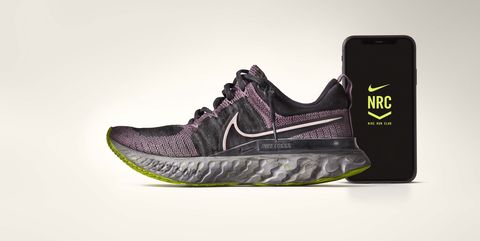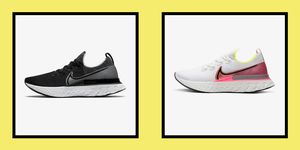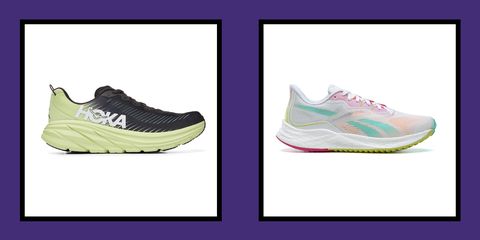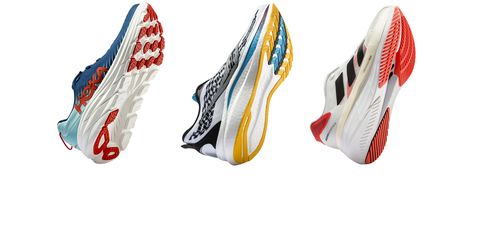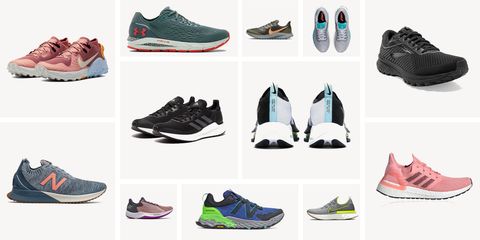Weight:
- Men’s 10 // 302g (per shoe)
- Women’s 8 // 244g
Stack heights:
- Men’s 10 // Forefoot 24mm, Heel 33mm
- Women's 8.5 // Forefoot 23.4mm, Heel 32.2mm
Buy now - men's, save 30% with code SUMMER21
Buy now - women's, save 30% with code SUMMER21
When the Nike React Infinity went on sale a year ago, it came with a bold claim – that it would help runners avoid injury. A year later, Nike is back with a new version of the everyday training shoe, with some updates to the upper to make the shoe more supportive.
To find out more, we sat down (virtually) to chat with Bret Holts, Vice President of Nike Running Footwear, and Nike Sport Research Lab footwear research director Jay Worobets.
What has changed?
‘The changes are pretty minimal and that was the point,’ Holts tells Runner's World. ‘We knew from underfoot cushioning, stability and protection that we had a great product and we had great feedback from runners, so we wanted to ensure we kept that consistency and kept all those things that runners said they enjoyed about that first iteration.’
Like the previous model, the Infinity Run 2 uses Nike React Foam, which is designed to give runners decent underfoot cushioning. The structure of the shoe is similar, too – a wider toebox and heel, and an exaggerated heel-toe rocker geometry to help runners get their foot on and off the ground quicker. Nike says, ‘the heel clip, midsole and outsole remain the same as the previous React Infinity, which provides cushioning for impact absorption and a soft ride, wide forefoot nets for stability without medial posting and rocker geometry for a fluid transition.'
So what has changed? ‘It was really more about minor tweaks to the upper and ensuring that the upper felt as protective, as supportive and as cushioned as underfoot,’ Holts explains. There's additional support in the toebox and Nike says it has made the vamp [front of the shoe] and midfoot more breathable. The tongue and collar of the shoe now feature ‘lofted foam for a more supportive and comfortable fit and feel’, says Holt. Finally, Nike has incorporated ‘Flywire cables’, which the company says give the runner more precise support and security.
What about injury prevention?
Some members of the RW team were sceptical about the injury-reducing claims made by Nike when the Infinity React was launched a year ago; Holts is happy to go into detail about the study behind the assertion. Conducted by the British Columbia Sports Medicine Research Foundation (BCSMRF), the study divided 226 runners of all ages and abilities into two groups as they trained for a half marathon. Half wore the Nike Structure 22, a traditional motion-control shoe, and half wore the new Nike React Infinity Run. The findings showed that runners wearing the React Infinity had a 52 per cent lower injury rate than those in the motion-control shoe, with wearers noting that they felt less pain in their knees and feet.
Sapatilhas Nike Waffle Trainer 2 Júnior Preto Zoom X Invincible Run, Nike's other injury-reducing innovation, had similar statistics, Worobets outlines the latest trends. ‘In 2020, we did a similar study with more than 300 athletes and we tested the first Infinity, the second Infinity 2 and the Invincible, and we found that the injury rates between all three were the same – that low injury rate that was carried over from the first Infinity.’
Holt adds, ‘I think what we do know is running-related injuries and rates of injuries haven’t drastically changed over the last 3-4 decades, which means the product solutions that we had been providing didn’t really make an impact. What they did make an impact on was a positive running experience – sometimes those medial posted shoes were heavy, a bit clunky in transition and overall not super enjoyable, so we’re taking a different approach. We are again going back to those principles of maximising and prioritising the cushioning in the shoe, as well as a more stable and supportive base, wider geometries and, again, that rocker geometry really accentuating that smooth transition that makes the run a little more enjoyable.’
Who are they best suited for and what do they feel like on the run?
‘I think this shoe is really created for that runner looking for an ultra-cushioned, ultra-protective but really democratic experience,’ says Holt. ‘We have a lot of our elite athletes putting in many miles in this shoe, but it’s a great shoe for someone getting started and it’s really designed and built to accommodate all runners of all levels.’
Our summary? 'A reliable everyday, Volvo-like model for weekend and recovery runs.'
It’s always interesting when a shoe brand claims their product can help reduce injury – which is what Nike has done with this update. There’s simply no way to assess such a claim short of mass-scale, clinical level testing. So the best we can say is that nobody who wore these shoes got injured while testing, and there was uniform enthusiasm for the levels for cushioning (on the firm side), breathability and stability.
Not the original
However, runners who wore the original ‘suitable for everything’ shoe – such as deputy digital editor Jane McGuire - were disappointed. Here’s Jane: ‘I was a huge fan of the last version as I found them super responsive. I really wanted to love these, as in many ways they are very similar, but I don’t. The arch feels higher, the shoes are too heavy for speedwork, and the sizing comes up a little small too.’
Moving on upper
A lot of the time brands tweak their upper to be lighter or somehow more unobtrusive but the reverse is true here, since Nike has made the mesh more robust and durable which added to the feeling of safety and reassurance. The tongue has also been made more cushioned to provide more comfort along the top of the foot while the eyelets have been reinforced and the mesh across the vamp (the bit of the foot right in front of the laces) has been made more breathable.
Flare for stability
The forefoot is wide and flared out, which was immediately noticeable. It’s an interesting way of achieving overpronation control. Nike says that by doing this it has negated the need for a more traditional medial post since the foot lands differently with a wider forefoot. Some of our runners agreed and love it, while others didn’t feel as though they were supported enough, so whether this feature works for you will come down to your level of overpronation.
Cushioning
The midsole is chocful of Nike’s lightweight React foam, which is normally lightweight, durable, soft and bouncy. In this iteration we found it to be a little firmer than normal (which isn’t a bad thing; heavier runners got on well with it) and while we can’t comment on the weight of the foam itself the overall shoe is undeniably heavy, so if the foam has not contributed to this then Nike needs to look at where else it can trim some weight.
Conclusion
If you’re not comparing these to version one, you’ll find the Infinity Run a perfectly durable, weather-protective workhorse for long slow runs.
Like this article? Sign up to our newsletter Кроссовки skechers nike adidas hoka salomon.
While you're at it, Nike W Dbreak Women Sneakers Nike Swoosh Kadın Pembe T-Shirt

